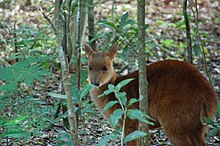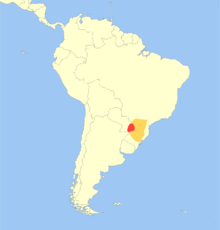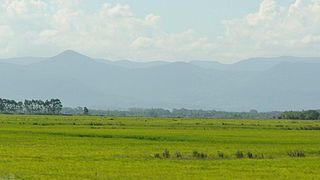
The Pampas are fertile South American low grasslands that cover more than 1,200,000 square kilometres (460,000 sq mi) and include the Argentine provinces of Buenos Aires, La Pampa, Santa Fe, Entre Ríos, and Córdoba; all of Uruguay; and Brazil's southernmost state, Rio Grande do Sul. The vast plains are a natural region, interrupted only by the low Ventana and Tandil hills, near Bahía Blanca and Tandil (Argentina), with a height of 1,300 m (4,265 ft) and 500 m (1,640 ft), respectively.
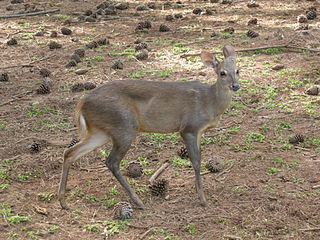
Brockets or brocket deer are the species of deer in the genus Mazama. They are medium to small in size, and are found in the Yucatán Peninsula, Central and South America, and the island of Trinidad. Most species are primarily found in forests. They are superficially similar to the African duikers and the Asian muntjacs, but only distantly related. About 10 species of brocket deer are described.
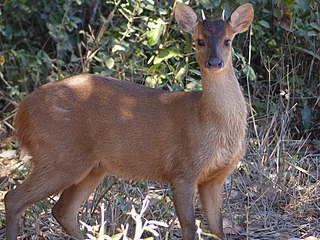
The red brocket is a species of brocket deer from forests in South America, ranging from northern Argentina to Colombia and the Guianas. It also occurs on the Caribbean island of Trinidad.

The marsh deer is the largest deer species from South America.

The gray brocket, also known as the brown brocket, is a species of brocket deer from northern Argentina, Bolivia, southern Peru, eastern and southern Brazil, Paraguay, and Uruguay. It formerly included the Amazonian brown brocket and sometimes also the Yucatan brown brocket as subspecies. Unlike other species of brocket deer in its range, the gray brocket has a gray-brown fur without reddish tones.

The Serra do Mar coastal forests is an ecoregion of the tropical moist forests biome. It is part of the Atlantic Forest of eastern South America. This ecoregion has an outstanding biodiversity consisting of flora, mammals, birds, and herpetofauna.

The dwarf brocket, or chunyi, is a small species of deer native to the Andean highlands in western Bolivia and southeastern Peru, where it is found in forest and páramo. Its pelage is reddish-brown with dark grey foreparts and neck. The underparts are lighter brown, and the muzzle short and thick. It weighs around 11 kg.

The little red brocket or swamp brocket, also known as the Ecuador red brocket, is a small, little-studied deer native to the Andes of Colombia, Ecuador and northern Peru, where found in forest and páramo at altitudes between 1,400 and 3,600 metres. It is one of the smallest brocket deer. The coat is reddish, and the legs and crown are blackish. As recently as 1999, some authorities included both the pygmy brocket and Merida brocket as subspecies of the little red brocket.

The Yucatan brown brocket is a small species of deer native to Central America.

The small red brocket is a small species of deer in the family Cervidae. It is endemic to Atlantic Forest in Paraná, Santa Catarina and São Paulo in southeastern Brazil. This species, which only was scientifically described in 1996, is threatened by habitat loss. Though its size and structure most resemble that of the pygmy brocket, its coloration is very similar to that of the red brocket. It resembles hybrids between these two species even more closely, but differs from both, and their hybrids, in karyotype.

The Mérida brocket, also known as the Meroia brocket or rufous brocket, is a small species of deer. It is found in forest and páramo at altitudes of 1,000–3,500 metres (3,300–11,500 ft) in the Andes of northern Colombia and western Venezuela. It was once treated as a subspecies of the similar little red brocket, but has been considered a distinct species since 1987, though as recent as 1999 some maintained it as a subspecies.
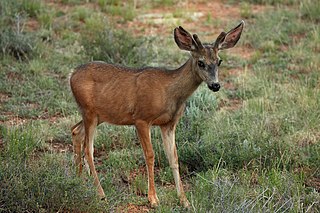
The Capreolinae, Odocoileinae, or the New World deer are a subfamily of deer. Alternatively, they are known as the telemetacarpal deer, due to their bone structure being different from the plesiometacarpal deer subfamily Cervinae. The telemetacarpal deer maintain their distal lateral metacarpals, while the plesiometacarpal deer maintain only their proximal lateral metacarpals. The Capreolinae are believed to have originated in the Middle Miocene, between 7.7 and 11.5 million years ago, in Central Asia.
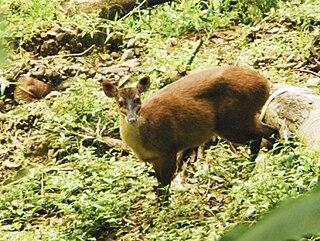
The Central American red brocket is a species of brocket deer ranging from southern Mexico, through Central America, to northwestern Colombia.
Cerradomys scotti, also known as Lindbergh's oryzomys, is a rodent species from South America in the genus Cerradomys. It is terrestrial and is found in the cerrado (savanna) ecozone of south central Brazil, Bolivia and Paraguay. The species is common and appears to tolerate a degree of agricultural habitat modification.

The Amazonian brown brocket, also known as the small brown brocket, is a small species of deer that is almost entirely restricted to South America.

The Prosa State Park, formerly the Parque dos Poderes, is an urban state park in the state of Mato Grosso do Sul, Brazil. It protects a remnant of cerrado vegetation, and is home to a wildlife rehabilitation center.
